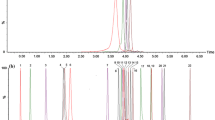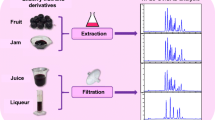Abstract
Anthocyanins are a group of widespread natural phenolic compounds in vegetables and fruits. The anthocyanins have a wide range of applications due to the antioxidant, anticancer and anti-inflammatory properties. In this study, anthocyanins (delphinidin-3-o-glucoside, cyanidin-3-o-glucoside, pelargonidin-3-o-glucoside and malvidin-3-o-glucoside) in cherry and cranberry were determined using high-performance liquid chromatography–electrospray ionization–mass spectrometry (HPLC–ESI–MS). The anthocyanins were separated using gradient elution and a reserved-phase analytical column before identification by high-performance liquid chromatography–electrospray ionization–mass spectrometry. A high-performance liquid chromatography–electrospray ionization–mass spectrometry method was optimized for the determination of anthocyanins in cherry and cranberry. Furthermore, in this study, we investigated extraction conditions of fruit samples as well as determination of optimum HPLC–ESI–MS conditions. This study is novel in terms of simultaneously examining both optimization of HPLC parameters and extraction conditions. Obtained optimum conditions were used for the determination as the quantitative and qualitative analysis of anthocyanins in cherry and cranberry. The content of anthocyanins on the basis of wet weight in cherry and cranberry samples was determined for delphinidin-3-o-glucoside <d.l. (detection limit) and <d.l., for cyanidin-3-o-glucoside varied from 3.5 ± 0.4 to 8.3 ± 1.1 mg kg−1 (average 5.8 ± 0.8 mg kg−1) and 9.8 ± 1.4 to 18 ± 3.0 mg kg−1 (average 13.2 ± 1.8 mg kg−1), for pelargonidin-3-o-glucoside <d.l. and varied from 136 ± 19 to 233 ± 35 mg kg−1 (average 185.3 ± 28 mg kg−1), for malvidin-3-o-glucoside <d.l. and <d.l., respectively.


Similar content being viewed by others
References
Rommel A, Wrolstad RE, Heatherbell DA (1992) Blackberry juice and wine: processing and storage effects on anthocyanin composition, color and appearance. J Food Sci 57:385–391
Andersen OM, Markham KR (2006) Flavonoids: chemistry, biochemistry and applications. CRC Press, Boca Raton, FL, pp 452–471
Kong JM, Chia LS, Goh NK, Chia TF, Brouillard R (2003) Analysis and biological activities of anthocyanins. Phytochemistry 64:923–933
Rein M (2005) Copigmentation reactions and color stability of berry anthocyanins. University of Helsinki, Helsinki, pp 10–14
Clifford MN (2000) Anthocyanins-nature, occurrence and dietary burden. J Sci Food Agric 80:1063–1072
Robards K, Antolovich M (1997) Analytical chemistry of fruit bioflavonoids review. Analyst 122:11R–34R
Veitch NC, Grayer RJ (2008) Flavonoids and their glycosides, including anthocyanins. Nat Prod Rep 25:555–611
Veitch NC, Grayer RJ (2011) Flavonoids and their glycosides, including anthocyanins. Nat Prod Rep 28:1626–1695
Seeram NP, Nair MG (2002) Inhibition of lipid peroxidation and structure-activity-related studies of the dietary constituents, anthocyanins, anthocyanidins and catechins. J Agric Food Chem 50:5308–5312
Seeram NP, Zhang Y, Nair MG (2003) Inhibition of proliferation of human cancer cell lines and cyclooxygenase enzymes by anthocyanidins and catechins. Nutr Canc 46:101–106
Konczak I, Zhang W (2004) Anthocyanins-more than nature’s colours. J Biomed Biotech 5:239–240
Nichenametla SN, Taruscio TG, Barney DL, Exon JH (2006) A review of the effects and mechanisms of polyphenolics in cancer. Crit Rev Food Sci Nutr 46:161–183
Lule SU, Xia W (2005) Food phenolics, pros and cons: a review. Food Rev Intern 21:367–388
Stintzing FC, Carle R (2004) Functional properties of anthocyanins and betalains in plants, food, and in human nutrition. Trend Food Sci Tech 15:19–38
Giusti MM, Wrolstad RE (2003) Acylated anthocyanins from edible sources and their applications in food systems. Biochem Eng J 14:217–225
Harborne JB, Williams CA (2000) Advances in flavonoid research since 1992. Phytochemistry 55:481–504
Cooper-Driver GA (2001) Contributions of jeffrey harborne and co-workers to the study of anthocyanins. Phytochemistry 56:229–236
Harborne JB, Williams CA (1998) Anthocyanins and other flavonoids. Nat Prod Rep 15:631–652
Brouillard R, Chassaing S, Fougerousse A (2003) Why are grape/fresh wine anthocyanins so simple and why is it that red wine color lasts so long? Phytochemistry 64:1179–1186
Wrolstad RE, Durst RW, Lee J (2005) Tracking color and pigment changes in anthocyanin products. Trend Food Sci Tech 16:423–428
Martens S, Knott J, Seitz CA, Janvari L, Yu SN, Forkmann G (2003) Impact of biochemical pre-studies on specific metabolic engineering strategies of flavonoid biosynthesis in plant tissues. Biochem Eng J 14:227–235
Da Costa CT, Horton D, Margolis SA (2000) Analysis of anthocyanins in foods by liquid chromatography, liquid chromatography–mass spectrometry and capillary electrophoresis. J Chromatogr A 881:403–410
Simmonds MSJ (2003) Flavonoid–insect interactions: recent advances in our knowledge. Phytochemistry 64:21–30
Castaneda-Ovando A, Pacheco-Hernandez ML, Paez-Hernandez ME, Rodriguez JA, Galan-Vidal CA (2009) Chemical studies of anthocyanins: a review. Food Chem 113:859–871
Kaplan O, Kaya G, Ozcan C, Ince M, Yaman M (2009) Acrylamide concentrations in grilled foodstuffs of Turkish kitchen by high performance liquid chromatography-mass spectrometry. Microchem J 93:173–179
Versari A, Barbanti D, Biesenbruch S, Farnell PJ (1997) Analysis of anthocyanins in red fruits by use of HPLC/spectral array detection. Ital J Food Sci 9:141–148
Nyman NA, Kumpulainen JT (2001) Determination of anthocyanidins in berries and red wine by high-performance liquid chromatography. J Agric Food Chem 49:4183–4187
Doka O, Ficzek G, Bicanic D, Spruijt R, Luterotti S, Toth M, Buijnsters JG, Vegvari G (2011) Direct photothermal techniques for rapid quantification of total anthocyanin content in sour cherry cultivars. Talanta 84:341–346
White BL, Howard LR, Prior RL (2010) Proximate and polyphenolic characterization of cranberry pomace. J Agric Food Chem 58:4030–4036
Usenik V, Fabric J, Stampar F (2008) Sugars, organic acids, phenolic composition and antioxidant activity of sweet cherry (Prunus avium L.). Food Chem 107:185–192
Bonerz D, Würth K, Dietrich H, Will F (2007) Analytical characterization and the impact of ageing on anthocyanin composition and degradation in juices from five sour cherry cultivars. Eur Food Res Technol 224:355–364
Mitic MN, Obradovic MV, Kostic DA, Micic RJ, Pecev ET (2012) Polyphenol content and antioxidant activity of sour cherries from Serbia. Chem Ind Chem Eng Q 18:53–62
Arakawa O, Hori Y, Ogata R (1985) Relative effectiveness and interaction of ultraviolet-B, red and blue light in anthocyanin synthesis of apple fruit. Physio Plant 64:323–327
Faragher JD (1983) Temperature regulation of anthocyanin accumulation in apple skin. J Exp Bot 34:1291–1298
Can NO, Arli G, Atkosar Z (2012) Rapid determination of free anthocyanins in foodstuffs using high performance liquid chromatography. Food Chem 130:1082–1089
Simunic V, Kovac S, Gaso-Sokac D, Pfannhauser W, Murkovic M (2005) Determination of anthocyanins in four Croatian cultivars of sour cherries (Prunus cerasus). Eur Food Res Technol 220:575–578
Grigoras CG, Destandau E, Zubrzycki S, Elfakir C (2012) Sweet cherries anthocyanins: an environmental friendly extraction and purification method. Sep Purif Technol 100:51–58
Yilmaz FM, Karaaslan M, Vardin H (2015) Optimization of extraction parameters on the isolation of phenolic compounds from sour cherry (Prunus cerasus L.) pomace. J Food Sci Technol 52(5):2851–2859
Cesoniene L, Jasutiene I, Sarkinas A (2009) Phenolics and anthocyanins in berries of European cranberry and their antimicrobial activity. Medicina (Kaunas) 45:992–999
Wu XL, Prior RL (2005) Systematic identification and characterization of anthocyanins by HPLC-ESI-MS/MS in common foods in the United States: fruits and berries. J Agric Food Chem 53:2589–2599
Acknowledgments
This work was financially supported by scientific research projects units of Firat University (Project Number: FF.11.02).
Author information
Authors and Affiliations
Corresponding author
Ethics declarations
Conflict of interest
Authors declare no conflict of interest.
Compliance with ethics requirements
This article does not contain any studies with human or animal subjects.
Rights and permissions
About this article
Cite this article
Karaaslan, N.M., Yaman, M. Determination of anthocyanins in cherry and cranberry by high-performance liquid chromatography–electrospray ionization–mass spectrometry. Eur Food Res Technol 242, 127–135 (2016). https://doi.org/10.1007/s00217-015-2524-9
Received:
Revised:
Accepted:
Published:
Issue Date:
DOI: https://doi.org/10.1007/s00217-015-2524-9




